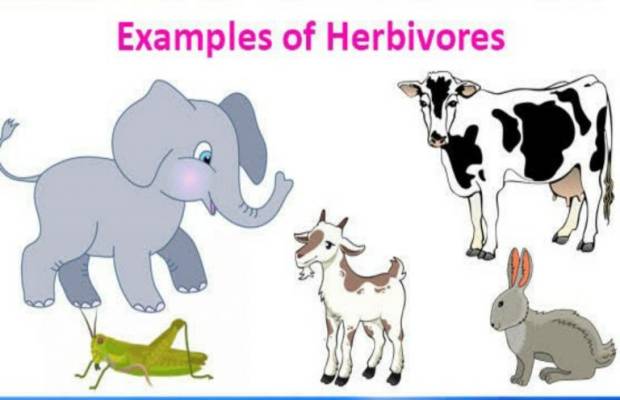Differences Between Herbivores And Carnivores

Analysing the diet and feeding habits of an animal is one way to categorise it. Carnivores and herbivores are the two types of animals that fit into these categories. Herbivores and carnivores differ primarily in their various ways. Herbivores are animals that only eat plant material, whereas carnivores only eat meat.
These two groups of animals are very different from one another in terms of appearance and feeding. Numerous physiological traits, especially those related to the mouth and digestive system, are shaped by their eating habits.
The existence of organisms in these two categories is crucial for maintaining the energy balance of the ecosystem through food chains. The differences between herbivores and carnivores are described in detail below.
What are herbivores?
The energy animals are classified as herbivores and are thought to be the lowest rungs of the food chain. Plants are directly capable of storing their stored energy. When it comes to their teeth, herbivores differ from carnivores and omnivores in that they have broad, flat, spade-shaped incisors, dull, short canines, or none at all, and molars with flat cusps. Canines and incisors are used to pick up plant material, which is then placed in the mouth and mashed using broad-ridged molars.
Herbivores can chew through huge objects because plant materials don't taste very good. For this reason, their jaw point is immediately above the plane of teeth. Herbivore saliva contains enzymes that break down carbs.
READ ALSO » Major Differences Between Developed And Developing Countries
Carnivores and omnivores, on the other hand, are not likely to encounter this (save in humans). One or more chambers in the stomach are used for the digesting of plant material. The short intestines of herbivores are 10–12 times longer than their bodies, increasing the amount of surface area available for food absorption. Like humans, they can sacculate and have a lengthy colon.
What are carnivores?
Carnivores are animals that only eat the meat of other animals. Large canines with razor-sharp edges that are meant to stab and tear the victim are a defining feature of meat-eaters. Their molars have sharp edges that help them grasp and shred the skin, and their incisors have small, pointed ridges. Similar to omnivores, carnivores' saliva is devoid of digestive enzymes.
Its small intestine is also three to six times longer than its whole length. Its liver can detoxify vitamin A, unlike herbivores. The nails have been fashioned into sharp claws. Just as herbivores have certain adaptations that help them catch their prey, carnivores likewise have specific adaptations that help them do so.
Carnivorous animals have a wealth of information.
The following descriptions of these creatures are applicable in light of these details: As carnivores, raccoons and red pandas eat meat infrequently. Not all creatures that eat flesh are carnivores. These critters can only move their jaws up and down.
They can't even flex their jaws sideways. Carnivores all descended from a single common ancestor. They possess an uncomplicated and well-structured digestive system. Dogs, wolves, and lions are a few instances of sociable carnivorous animals.
Key Difference Between Herbivores and Carnivores.
1. An animal is considered a herbivore if it exclusively consumes plants and their leftovers. creatures classified as carnivores, on the other hand, consume the meat of other creatures. While these critters consume using their mouths, their mouth holes are exceedingly small. These creatures tear away the flesh with their fangs and have enormous mouth holes.
2. The complex facial muscles found in herbivores. Compared to other animals, carnivores' facial muscles are weaker. In these animals, the mouth-to-head ratio is very small. A carnivore's head-to-mouth ratio is out of proportion. The broad, flat, and short teeth of herbivorous animals are employed for chewing and grinding plant leaves, grains, and seeds. Carnivorous animals possess long, sharp, and curved canines and incisors, which are utilised to tear flesh.
3. Herbivore digesting enzymes are present in their saliva. Carnivores, however, do not have digestive enzymes in their saliva. Herbivores can have single or many chambers in their stomachs. Carnivores, on the other hand, have a simple stomach with only one chamber. Herbivores have short intestines that are twice as long as their bodies. The short intestines of carnivores are as long as their bodies.
4. The concentration of urine in herbivores is very low. The urine of carnivores is extremely concentrated. Herbivores only consume plants and other vegetation. Rather than eating other animals, carnivores primarily consume herbivores.
Herbivore teeth are characterised by their sharp incisors and efficient grinding abilities. Carnivores have canines that are sharp and teeth that grind. The majority of herbivores have several stomach chambers. Additionally, their digestive tracts are longer than those of carnivores. Animals having many stomach chambers are called ruminants.
Carnivores have easier digestion. They also have a shorter digestive system and only one stomach chamber.
5. Herbivores are not built for hunting and have reduced body proportions. In contrast, carnivores have larger, more aggressive body sizes. Herbivore claws are flat and blunt. In contrast, carnivores chase their prey with their long, sharp claws.
Several species of herbivores can be distinguished based on the sorts of plant material that they eat. Granivores, folivores, nectarines, and eaters of seeds, leaves, and fruits are the terms used to describe these creatures.
Additional types of carnivores are facultative and obligatory carnivores. While obligatory carnivores must only eat meat, facultative carnivores can survive on a diet that includes both meat and non-animal sources.
READ ALSO » 10 Tips And Strategies For Developing Self-discipline And Overcoming Procrastination
6. Because herbivores consume plants, their teeth are designed specifically for this function. Taking cows as an example, their large, flat teeth allow them to chew up plant material. The teeth of carnivores, on the other hand, are well adapted to hunting and breaking down prey.
Lions, for example, have pointed, broad teeth and pointed incisors. Meat can be cut by even their teeth. Crushing hard plants is the primary function of the teeth and skulls of herbivores. The skulls of carnivores are capable of producing strong bites.
7. To help break down the copious amounts of carbohydrates and coarse fibre found in plant debris, herbivores have amylase in their saliva. Carnivores do not manufacture amylase in their saliva.
Instead, they must rely on their pancreas to break down carbohydrates. Examples of herbivores are many species. Folivores: Sloths and koalas Granivores include capybara and grey squirrels.
Fugivores include the white cockatoo, kakapo, and grey parrot. Hummingbirds only eat nectar. Examples of carnivores include the following. Carnivores like lions and tigers are a must. Canines are carnivores with faculties.
In the natural world, most animals obtain their energy from other creatures. We can categorise eating habits into two groups using this concept: herbivores and carnivores. In this post, we examined the differences between the two. The distinctions between herbivores and carnivores are outlined above.
